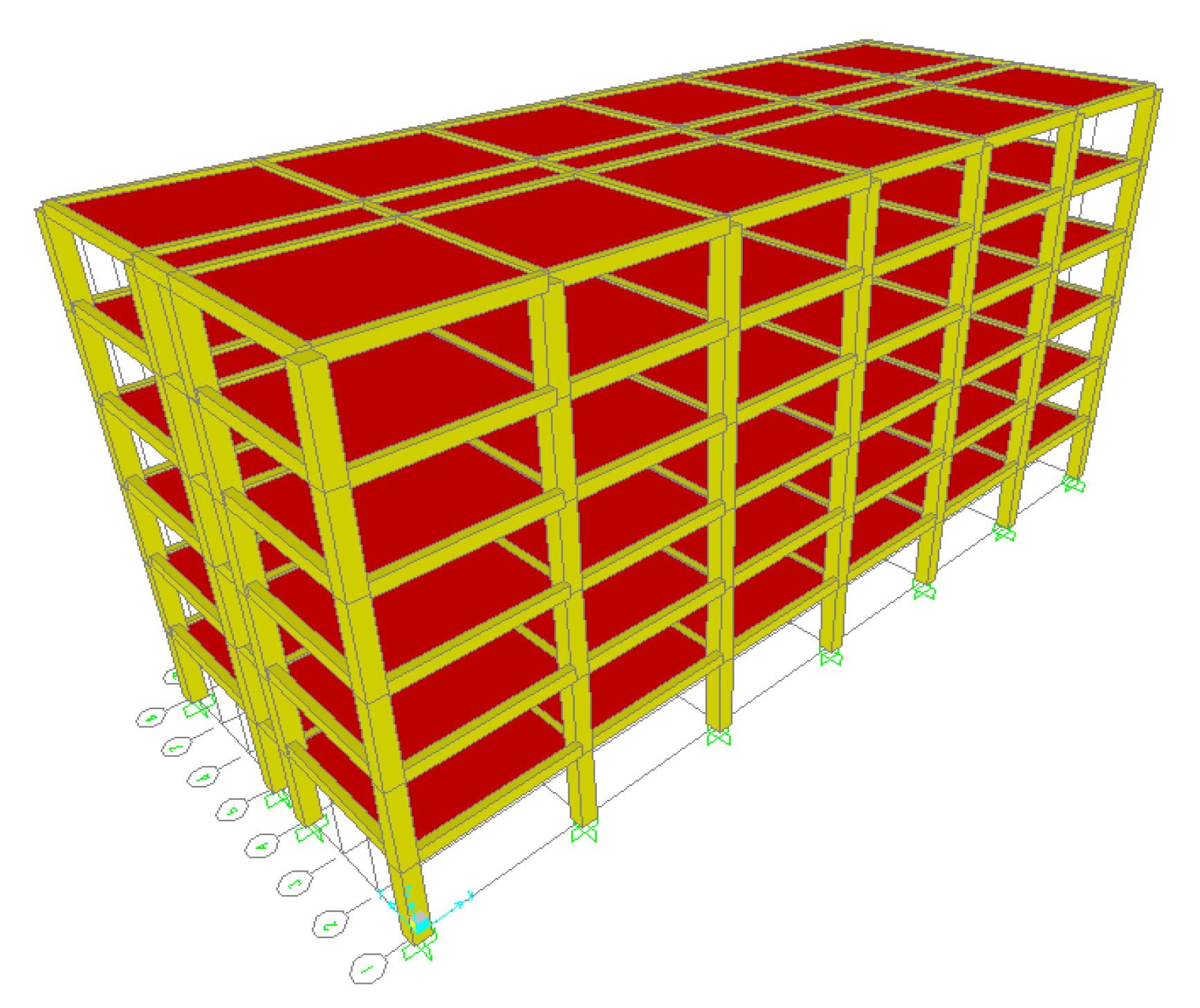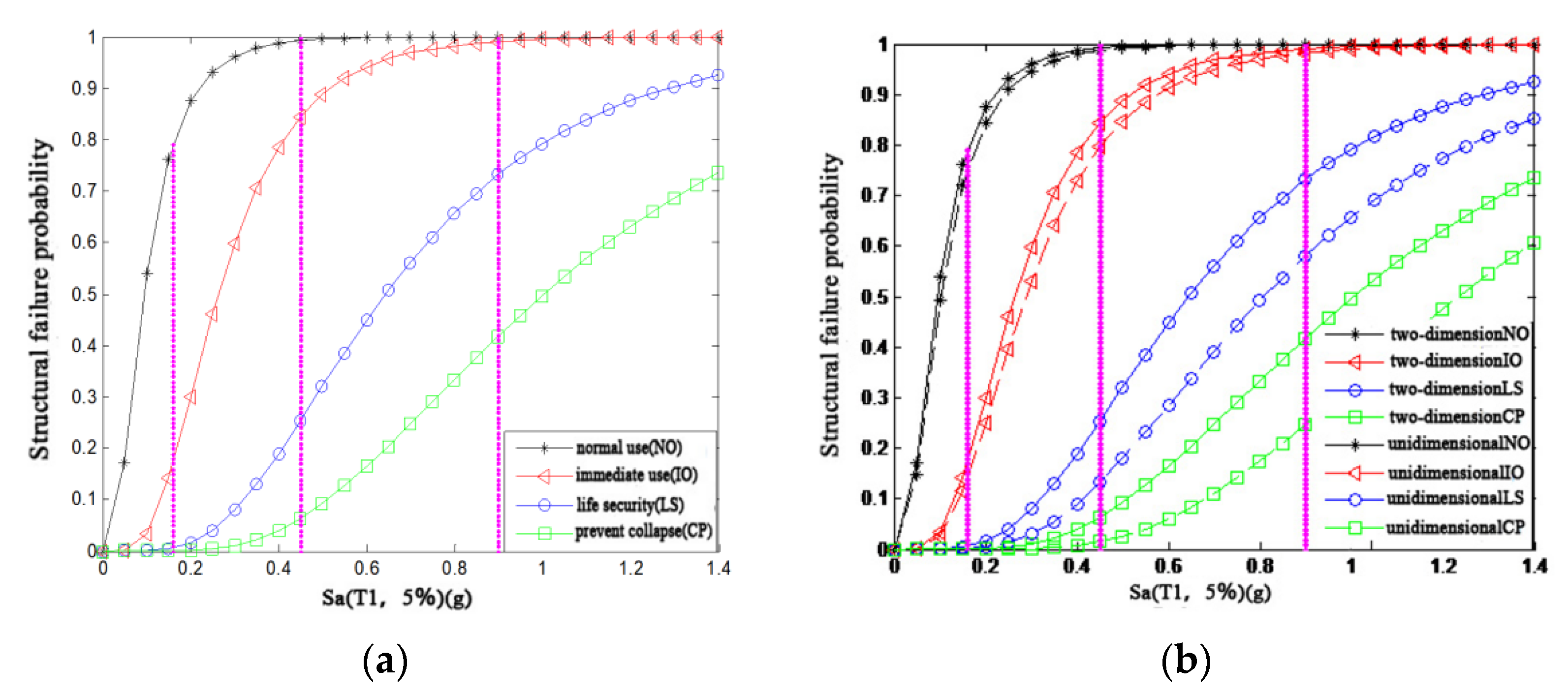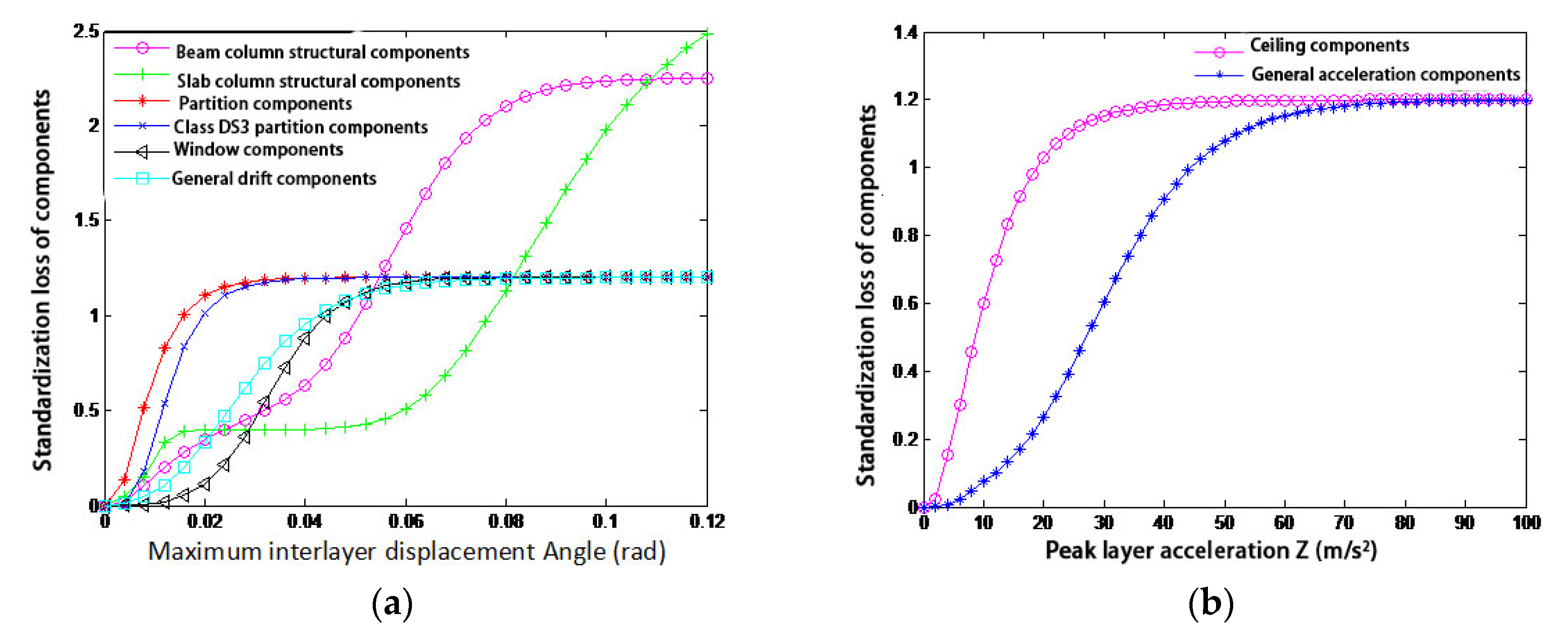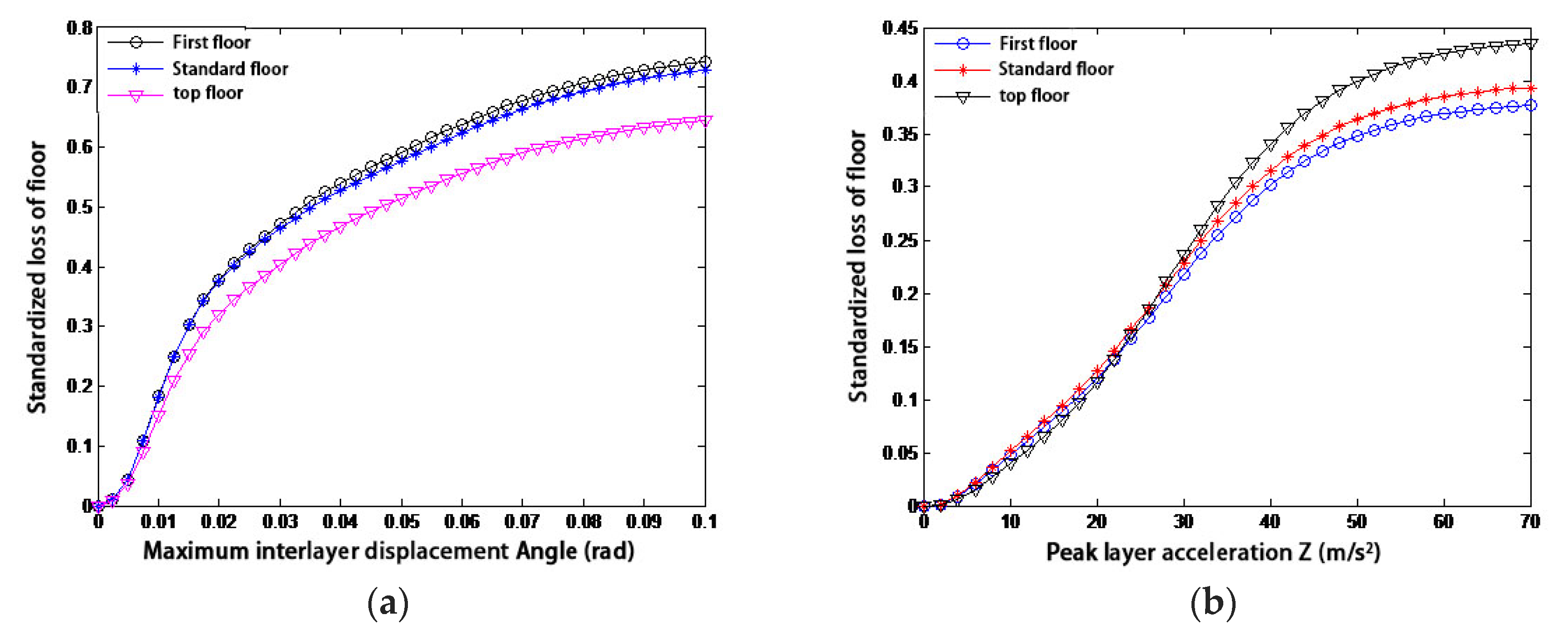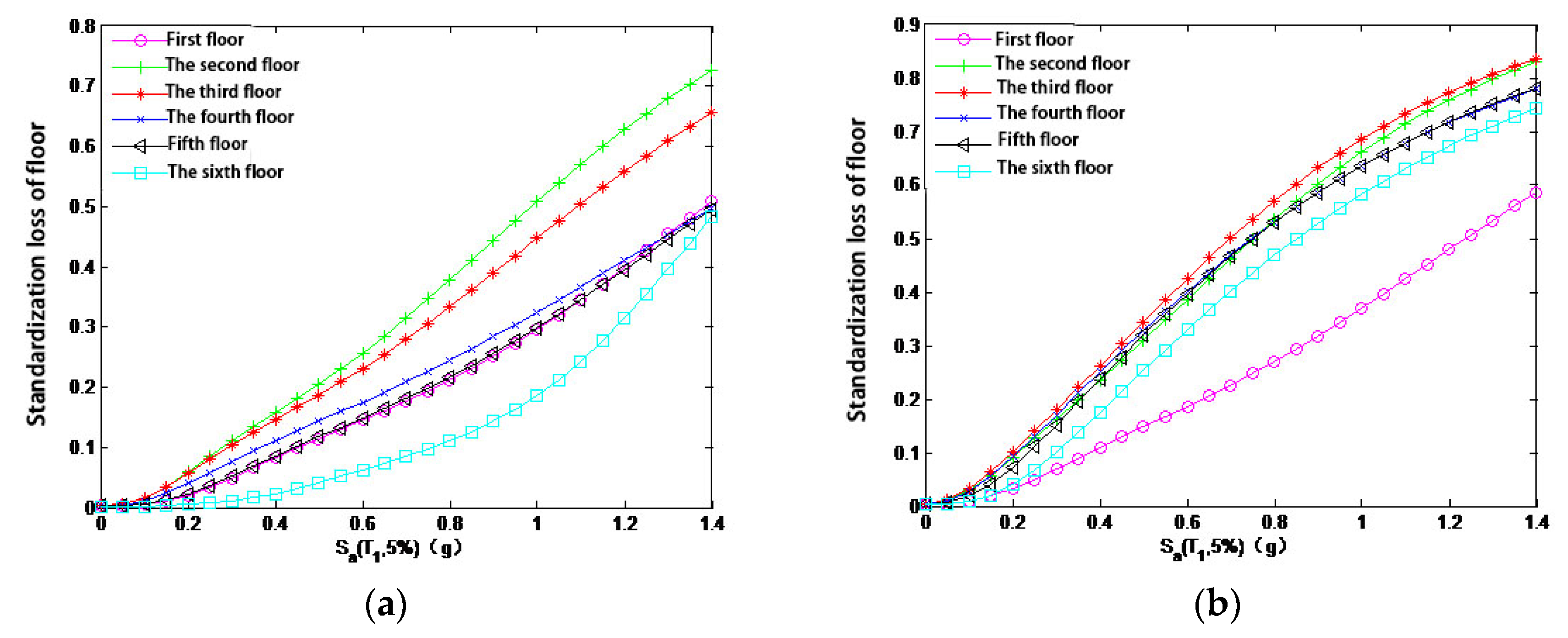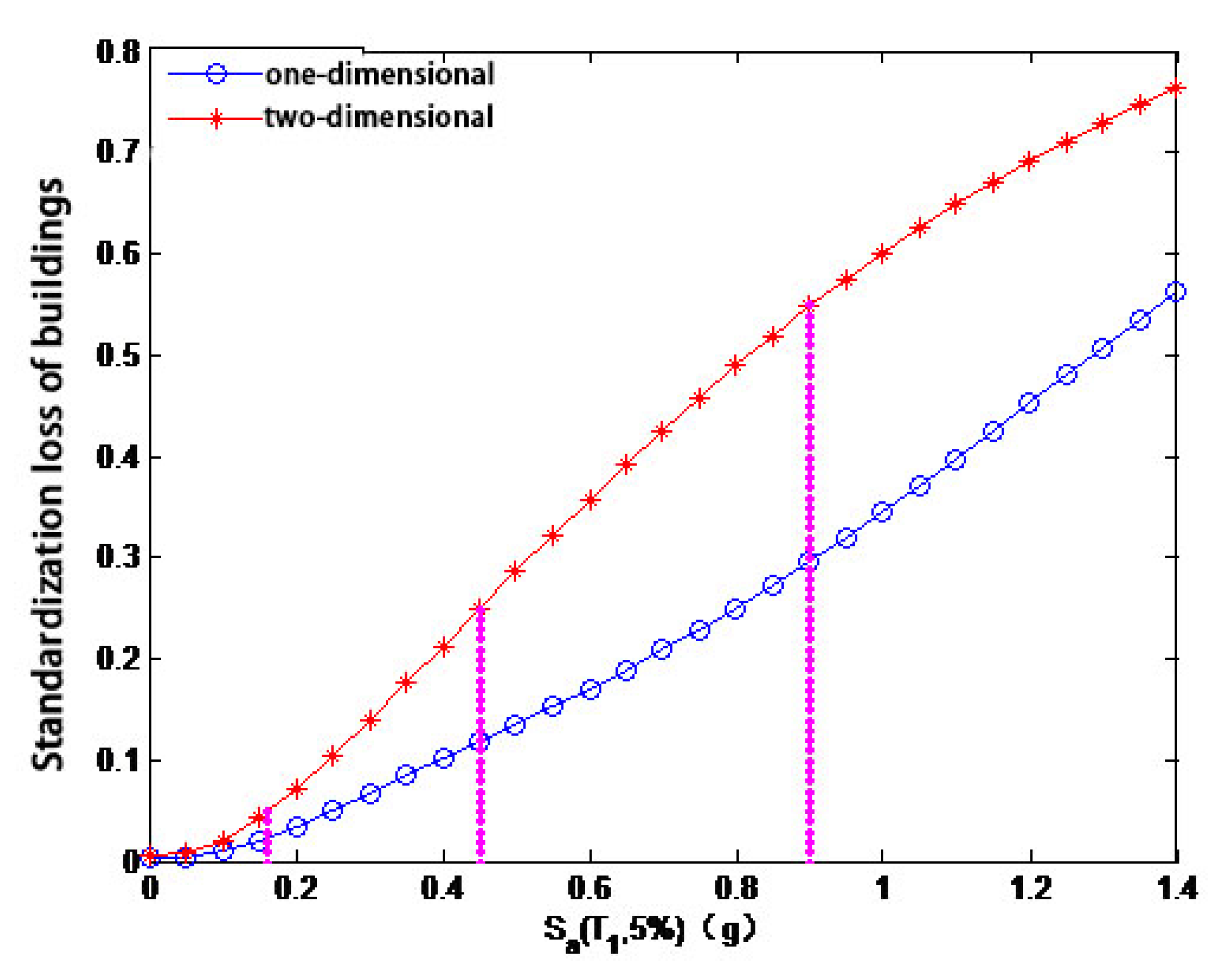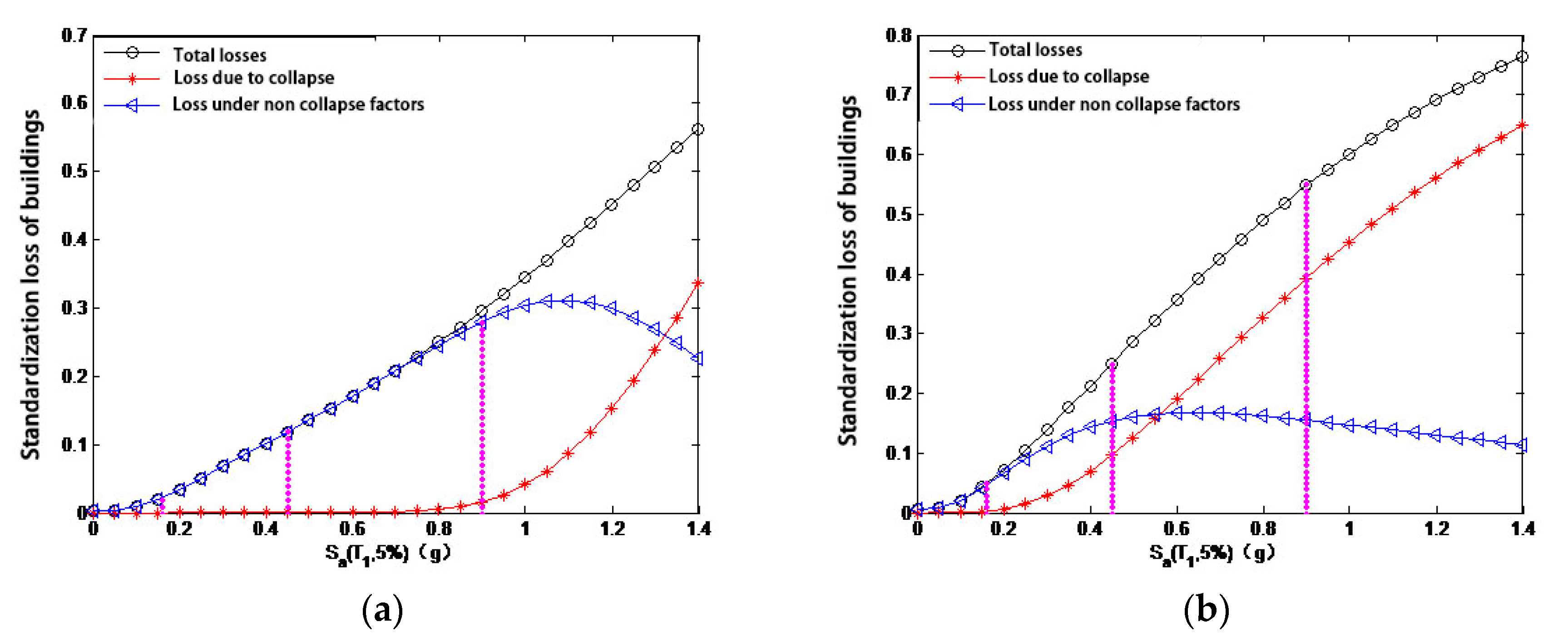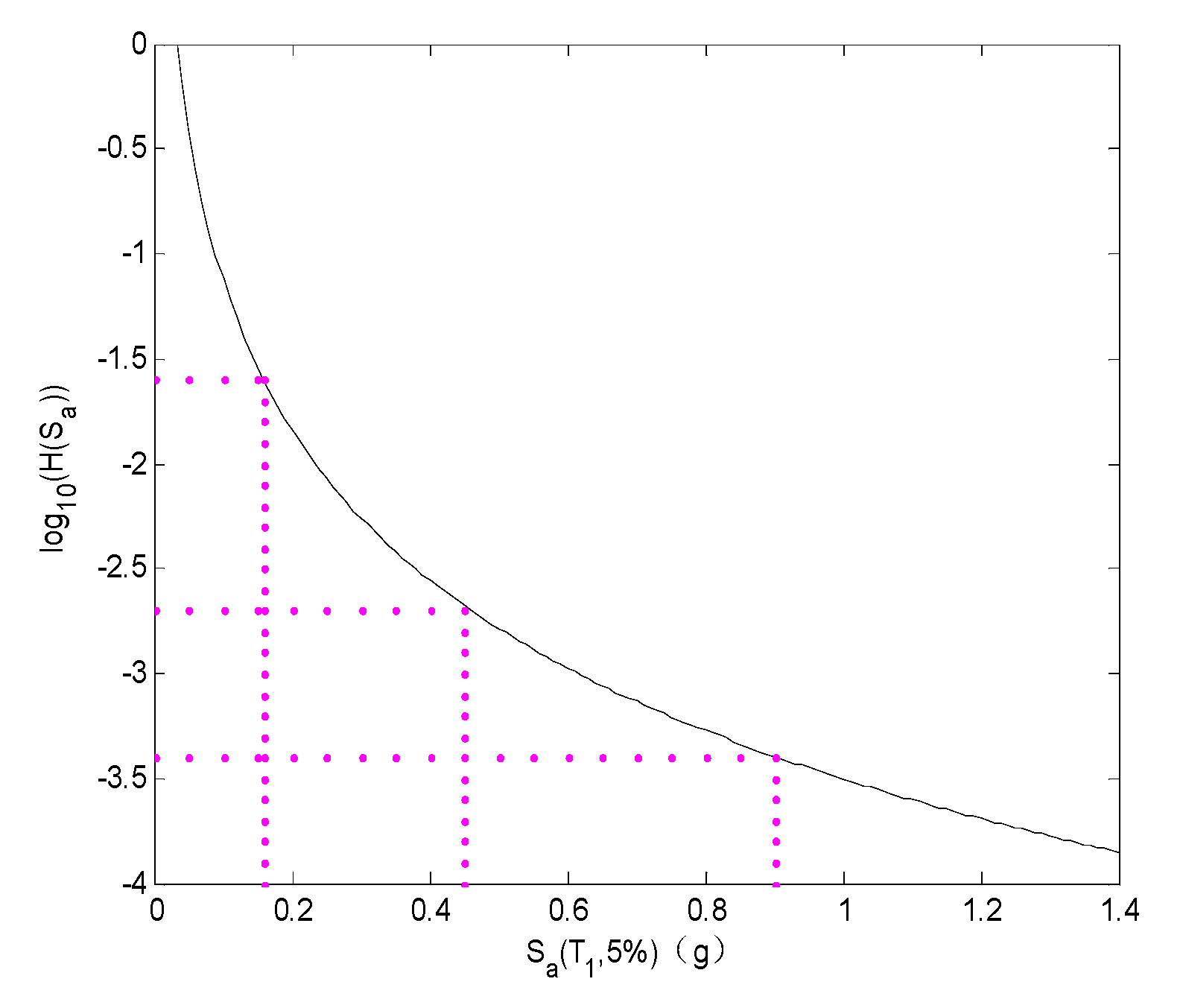1. Introduction
The current design standards attach great importance to the safety performance of the structure itself, which can effectively prevent the collapse of the system and the loss of people’s lives. On this basis, the economic losses from earthquakes will mainly come from the damage to nonstructural components and to the contents inside buildings, including—but not limited to—doors and windows, suspended ceilings, filler walls, various pipelines, and the various equipment placed in facilities. As people’s demands for building functions grow and the equipment erected in buildings becomes more expensive, the repair and replacement price of decorations, nonstructural components, and information technology equipment in buildings that are damaged as a result of earthquakes often exceeds the cost of the structure itself. Statistics show that investment in nonstructural parts and interior building items in general public buildings accounts for 80–90% of the cost [
1].
The mainstream design concept ignores the seismic design of the nonstructural components and the interior items of the building. The possible damage to building structures that are designed in accordance with the current seismic standards for buildings, for moderate and small earthquakes, is relatively limited. The nonstructural components may suffer severe damage when encountering medium and minor earthquakes. In the 2013 Lushan earthquake in China, which had a magnitude of 7.0, the nonstructural components, such as filler walls and ceilings, were seriously damaged, but the main structures of many of the public buildings remained intact [
2]. Computers and storage racks, along with other contents inside the building, were more likely to fall or turn over, thus suffering damage due to falling onto the floor.
Therefore, a method is needed to estimate the economic loss of a structure at a specific stage in its life cycle; one that can effectively help stakeholders undertake investment decisions and purchase adequate earthquake insurance. The United States of America and Japan have launched studies on this topic in previous years. In 1979, Scholl conducted a component-based damage assessment. Kutsu et al. [
3] considered the probability characteristics of component losses on the basis of Scholl [
4]. Vision 2000 defined the performance level and multiplicity targets, but its application of the worst component performance to represent the overall performance of the structure caused the loss assessment results to be conservative [
5]. Singhal and Kiremidjian [
6] considered an uncertainty of loss estimation regarding damage caused by ground motion. Porter and Kiremdjian [
7] proposed a probability method based on the assembly-based vulnerability of concrete buildings, and also used a Monte Carlo simulation to estimate the probability parameters of the damage function.
Aslani and Miranda presented a component-based direct economic loss estimation method under the framework of performance-based seismic engineering. Zareian et al. [
8] and Ramirez [
9] simplified their models and refined them to combine each layer of damage and each component into the fundamental component. Goulet [
10] proposed a new seismic evaluation method to quantify the structural performance of the economic loss and the collapse-resistant capacity of the structure. They used an office building as the research object to reach the conclusion that the average annual loss of the building was approximately 0.6–1.1% of the total cost. Gentile and Galasso [
11] used multiple criteria to assess the economic loss caused by earthquakes. Wang et al. [
12] advised that China’s current standards did not attach importance to damage to the nonstructural members of buildings caused by seismic acceleration. Kassem et al. [
13] improved the empirical vulnerability index of seismic vulnerability. Di et al. [
14] corrected the relationship between the availability level and economic loss by analyzing the empirical data of the L’Aquila earthquake (2009). You et al. [
15] proposed a new method to quickly determine the damage to the structural members of a building after an earthquake. Laguardia et al. [
16] summarized the relationship between the proposed vulnerability, framework, and loss curves by studying the damage to buildings in the L’Aquila earthquake (2009). Kang et al. [
17] proposed a method based on IDA to quantify the uncertainty and correlation of engineering demand parameters (EDPs). Sousa et al. [
18] considered the importance of indirect losses in the loss assessment of industrial buildings. Perez et al. [
19] proposed to estimate performance displays by accessing massive geospatial data. Bianchi et al. [
20] considered the impact of modeling uncertainty on earthquake economic loss assessments. You et al. [
21] found that spatial correlations affected the degree of earthquake loss. Foraboschi [
22,
23] considered the damage that occurred due to concentrated forces (e.g., the force produced by partitions at corners). Aloisio [
24] improved the seismic performance and seismic loss assessment method and applied it to timber structures. Gioiella [
25], on using an Italian school building as an example, showed the progress of seismic loss assessment methods.
In China, Zeng et al. [
26] gained the annual average exceedance probability of the structural response by applying incremental dynamic analysis to obtain the seismic response of the maximum relative displacement of the bearing, and then defined two performance levels. Ma et al. [
27] regarded the structural performance as continuous and adopted an improved capacity spectrum method. Yang et al. [
28] used the component-based direct economic loss evaluation method in the context of a performance-based seismic engineering framework, to determine the financial loss of reinforced concrete frame structures in high-earthquake-risk areas. Bi and Chen [
29] introduced the entropy weight method and similarity theory in fuzzy mathematics to group vulnerability. Zhou [
30] applied different structural dynamics methods to complete earthquake loss assessments on the basis of earthquake risk analysis. Liu and Lu [
31] used earthquake loss estimates to devise risk measures, such as annual exceedance probability and cumulative exceedance probability. These measures were used in financial engineering and catastrophe insurance to construct a more thorough risk assessment of earthquake-related losses.
However, the majority of the above studies began with a single dimension, which inevitably results in a disconnect between the constructed model and the actual issues, thus making it challenging to consider the accuracy and effectiveness of earthquake loss assessments. This paper introduces a multidimensional seismic vulnerability model based on 2D performance indicators, that considers the correlation between two performance indicators, as well as constructs a combined performance level based on previous studies. A six-story RC frame building is the research object used to develop the earthquake economic loss curve, and it is compared with a 1D earthquake loss curve in order to examine the influencing aspects that help assist stakeholders in making decisions.
4. Example Analysis
A finite element model can be established by taking a six-story steel–concrete frame structure as the research object, which can be found in
Figure 1. The model parameters are described as follows: six spans in length are 36 m, three spans in width are 14 m, the height is 19.8 m, the beam section area is 500 mm × 300 mm, the column section area is 600 mm × 600 mm, and the slab thickness is 100 mm. The reinforcement is conducted in accordance with the corresponding specifications: The elastic moduli of the concrete and steel bars are
, and the Poisson’s ratio is
, and
. In addition, the density of the reinforced concrete is
. Twenty groups of seismic inputs were selected and amplitude-modulated to six PGAs (0.05, 0.25, 0.55, 0.75, 0.90, and 0.05 g), thus representing seismic excitation. We used SAP2000 to establish the model and selected 20 seismic waves as the excitation input model for the elastic–plastic time history analysis. In this example, M3 hinges were specified at both ends of all beams and PMM hinges were specified at both ends of all columns. The hinge properties were based on the default hinge properties provided by SAP2000 in accordance with the FEMA356 specification. The bottom constraint type was to limit all translation and rotation. The structural response calculated by SAP2000 (i.e., the displacement response and acceleration response that are selected in this paper) was used as an index to analyze the vulnerability of the structure. The peak distribution of responses was estimated by the maximum likelihood, and the exceedance probability was calculated in accordance with the analytical expression of vulnerability to fit vulnerability, as is shown in Equations (1)–(9). The results obtained are shown in
Figure 2.
To simplify the calculation, this paper makes the following assumptions:
The whole building is used as office space rather than in a mixed-use capacity;
The main entrance, layout, facade, and polished surface of the first floor are different from those of other floors. Therefore, the replacement cost of the first floor is different from other floors;
As most of the building’s equipment is on the top floor, the replacement cost of the top floor is distinct from other floors;
The remaining middle floors are all used for office purposes, and these floors have the exact replacement cost.
In accordance with the above assumptions, the office building is divided into three floors: the first floor, the standard floor, and the top floor. The replacement cost of each floor is different. On the basis of the two-stage formation process of the floor response loss function described above, the response loss function of each floor is set up in the following two steps.
4.1. Creating a Floor Response Loss Function
In accordance with the related literature and previous engineering practices detailed in [
2,
35,
38,
39], we divided the building components into eight categories as follows:
Beam–column structure components;
Slab–column structure components;
Partition wall components;
DS3 partition wall components;
Window components;
General drift components;
Ceiling components;
Available acceleration components.
In accordance with
Table 3, the response vulnerability function
of various components can be established by using the log-normal cumulative distribution function. Combined with Equation (9), the component response vulnerability function
can obtain
component response vulnerability curves (the threshold value is
), and the
types of damage states (
) can be divided. The probability
that the damage state of the component reaches the given damage level under the given EDP level is derived from the component response vulnerability function
. The response vulnerability of various components can be established by substituting the loss function
of various components that were obtained previously and the probability
of various components reaching a given damage state under the given engineering requirement parameter level in Equation (8). The sixth function
is shown in
Figure 3.
To establish the response loss function of each floor, we needed the response loss function of various components and the ratio for the replacement cost of multiple parts to the replacement cost of the floor on a particular floor. On the basis of previous descriptions, the floor cost of the building in the calculation example was divided into three types: the first floor, the standard floor, and the top floor. After consulting the relevant specifications and literature, the replacement cost of a certain type of component in the calculation example and the floor replacement of the element were calculated as ratio
.
Table 4 lists the ratio of the replacement cost of the various components mentioned above for the first floor, standard floor, and top floor, with the replacement cost of the floor where such features are located [
39,
40]. As is shown in
Table 2, the sum of the component replacement cost to the floor replacement cost was less than 1. This condition was mainly because each floor contains particular components, such as slabs and roof openings. Damage only occurs when it collapses, so economic losses caused by such components are not included. The response loss functions of various elements in
Figure 3 and the ratio of the replacement cost of multiple parts to the replacement cost of the floor in
Table 2 were substituted into Equation (11). This was performed to establish the floor response loss functions of the first floor, the standard floor, and the top floor, as shown in
Figure 4.
4.2. Establish the Earthquake Intensity-Economic Loss Curve
In accordance with the 1D and 2D seismic vulnerability curves, the probability of an earthquake occurrence resulting in the damaged state of a structure under a given earthquake condition was deduced. The calculation methods of the seismic intensity–economic curves of other floors are similar, so this paper will not address them here. To establish the angle of the earthquake intensity–economic loss relation, we needed to standardize the loss of each damaged floor. The method adopted in this paper was to take the average value of the multiple simulations of the standardized loss of floors. The results are shown in
Table 5,
Table 6 and
Table 7.
In accordance with Equation (13), we obtained the standardized loss of the floor by multiplying the standardized loss of the floor under a given damage state with the probability of the structure under a given earthquake intensity, as shown in
Figure 5.
Figure 5a shows the earthquake intensity–economic loss curve of the floors under the 1D performance indicator. The economic losses of the other floors increased approximately linearly with the increase in earthquake intensity. This applied except for the top floor, which resulted in the second floor suffering the largest financial loss, and the sixth floor suffering the least.
Figure 5b shows the earthquake intensity–economic loss curve (by taking the correlation coefficient of the performance limit state
) of the floor under the 2D performance indicator. The economic loss of this floor considered the impact of nonstructural components. The financial failure of each floor did not increase approximately linearly with the increase in earthquake intensity, which resulted in the third floor suffering the largest economic loss, and the sixth floor the least.
The unit price of various components was determined by referring to the “National Unified Construction Engineering Fundamental Quotas” [
36]. The number of elements on each floor of the building was determined in accordance with the actual structure, and the replacement cost of each floor and the building could be calculated as the ratio of
. With this calculation, the cost distribution of the building was divided into three types: the first floor, the standard floor, and the top floor. In addition, the
ratios of the second floor to the fifth floor were the same. The specific situation is shown in
Figure 6.
The two curves in
Figure 6 are the seismic intensity–economic loss curves of the buildings when considering 1D and 2D performance indicators. Under the action of small earthquakes, a minimal difference was observed between the two curves. However, the gap between the two curves continuously increased with the increase in earthquake intensity. Under moderate and large earthquakes, the standardized loss difference of the buildings under 2D and 1D indexes exceeded 0.13 and 0.25, respectively. With the increase in earthquake intensity, when considering various influencing factors and the economic loss discrimination method of nonstructural components, the financial loss caused by an earthquake will be accurately estimated by comparing the two curves.
The economic losses caused by earthquakes can be divided into two groups: those caused by buildings collapsing, and those caused by buildings not collapsing. The formula for determining these losses is shown in Equation (18):
where
is the normalized loss of the building under the action of a given earthquake intensity;
and
are the normalized loss of the building under the action of a given earthquake intensity, as well as the collapse and noncollapse factors, respectively. Their calculation formulas are expressed by Equation (19):
where
is the normalized loss when the building collapses (which is the replacement cost of the building values 1);
is the collapse probability of the building under the action of a given earthquake intensity. The direct solution formula of
is cumbersome, so Equation (18) is transformed and obtained by subtracting the loss under the collapse factor from the total loss of the building.
Figure 7 is obtained by reviewing the content of
Figure 5 with Equation (17).
The analysis of
Figure 7a,b shows a remarkable difference between the 1D and 2D performance indexes of the building’s seismic intensity–economic loss curve decomposition diagram.
Figure 7a shows that the economic losses of buildings caused by small, medium, and large earthquakes are all incurred from the results of construction damage.
Figure 7b shows that the financial failure of buildings caused by moderate and small earthquakes is primarily driven by the noncollapse of structures and from component damage. By contrast, structural collapse is caused mainly by large earthquakes. This condition greatly defines the loss control direction of buildings under different earthquake intensities.
5. Estimation of Annual Average Economic Loss
At present, no accurate early warning system for earthquakes is available in the world; as such, we can assume that earthquakes are random events for the time being. Therefore, it is worth evaluating an earthquake’s economic loss in years. The annual average financial loss is related to the seismic risk of the site where the building structure is located and to the seismic performance of the system itself. The annual average economic loss of the building at a specific location is estimated. The seismic loss curve of the system can express the seismic performance of the structure itself, so seismic risk analysis based on the site is needed.
5.1. Seismic Risk Assessment
The most widely used method for seismic risk assessment is the probability analysis method [
41]. The final analysis results from this method include the annual average exceeding the probability of ground motion parameters, i.e., the seismic hazard curve. This method was first proposed by Cornell [
42]. The assumptions to simplify the model to be close to reality were as follows:
(1) The seismic activity is nonuniform, which indicates that an earthquake only occurs in some specific areas; furthermore, these particular areas are called potential hypocenter areas. Within the likely epicenter, the likelihood of an earthquake is the same everywhere;
(2) During the study period, the possibility of earthquake occurrence in each potential source region does not change with time;
(3) In each potential source area, the earthquake events are independent of each other, and the time course of earthquake occurrence obeys a Poisson distribution, i.e., the occurrence probability of
earthquakes in period
is:
where
is the average occurrence rate of earthquake events in time period
;
(4) In a potential epicenter area, the magnitude distribution of earthquake events is exponential, and the relationship between the number
of the magnitude is greater than
and the magnitude
is:
(5) In a specific site, the events that cause ground motions that exceed a given threshold by an earthquake event in a potential epicenter area obey the Poisson distribution. Specifically, the probability of the occurrence
of the event that the ground motion of a specific site exceeds the given threshold value is caused by the earthquake event in the
ith potential source area during the time period
is:
(6) In a specific site, the ground motion parameters are functions of epicentral distance and magnitude, which can be expressed as:
where
is the ground motion parameter;
is the magnitude; and
is the epicentral distance.
Considering the above assumptions, Cornell uses Equation (23) to represent the seismic hazard probability model of the design site [
32]:
where
is the earthquake hazard probability model of the site (represented in the form of an earthquake hazard curve), which represents the annual average exceedance probability of the earthquake intensity and is the main result of the earthquake hazard analysis; and,
and
are the values of the earthquake hazard curve. The shape parameters are determined by using Equations (23) and (24), according to the theory of Wu and Zhu [
43]:
where
and
are the seismic spectral accelerations that have a probability of exceeding 2% and 10%, respectively, during the 50-year design reference period of the structure (and which are the large earthquakes and fortification intensity earthquakes specified in the Code for Seismic Design of Buildings [
44]) (this also represents medium earthquakes); and
are the annual average exceedance probabilities when the seismic spectral acceleration is
and
, respectively, during the 50-year design reference period of the structure.
The research object of this paper was an office building. The seismic fortification intensity of the project area was a degree of 8, the design essential seismic acceleration value was 0.2 g, the equivalent shear wave velocity of the soil layer was 287.9 m/s, the site category was Class II, and the design earthquake group was Group III. According to the site characteristics of the structure, the basic natural vibration period, and the existing specifications, the interpolation analysis of the above two formulas obtained the seismic hazard curve of the site, as shown in
Figure 8.
5.2. Estimated Average Annual Economic Loss
On the basis of the full probability theorem formula proposed by Cornell and Krawinkler [
45], the annual average economic loss of a building can be obtained by integrating the seismic intensity–economic loss curve of the building and the seismic hazard curve of the site [
46], as is shown in Equation (27):
where
is the annual average economic loss of the building;
is the ground motion parameter (and the spectral acceleration
is selected as
in this paper);
is the normalized loss of the building under the action of a given earthquake intensity (see
Figure 5); and
is the earthquake intensity. The annual average probability of surpassing the loss is shown in
Figure 7.
The 1D and 2D performance indexes can be calculated by substituting the data into Equation (27), as well as the annual average economic loss of the building being 5.05% and 9.3%, respectively. From the data, the annual average economic loss of buildings under a 2D performance index is close to twice that of buildings under a 1D performance index.
